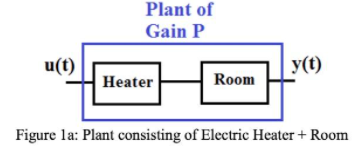la) Using P=7 |(fall time), caleulate the resulting temperature y and the corresponding control voltage u Ib) Using P=6 |(wintertime), calculate the resulting temperature yater and the corresponding control voltage uier lc) Calculate PD (CL). Compare with PD (OL). Explain qualitatively the reason for the increased robustness in closed loop (Hint, look at the control signal uiate, in OL and in CL)
![PROBLEM 1
We wish to control the temperature y(t) of a room with an electrical heater driven by an input
voltage u(t). This heater provides continuous control action, as opposed to the on-off heaters that
most of us have at home. Let us define the set electric heater-room (see Figure la) as “the plant".
Plant of
Gain P
u(t)
y(t)
Heater
Room
Figure la: Plant consisting of Electric Heater + Room
In the fall season, a voltage u(t) =10 [V] produces a room temperature ya = 70 ['F], and
therefore, the plant gain is P=7
In wintertime, with the outside low temperature as a perturbation, the same u(t) = 10 [V]
produces a room temperature of ywinter = 60 ['F], so the plant gain becomes P=6
V
For CASE 1 and CASE 2 below, let us measure the robustness of the control system, by
calculating the following percent difference (PD):
PD=all-Ywinterx100
y winter
The smaller PD, the more insensitive to perturbations is our control system. In other words, the
smaller PD, the more robust the control system is.
|Case 1: Open Loop (OL) Control
Case 2: Closed-Loop (CL) Control
Consider now a closed-loop depicted in Figure 1b:
r(t) +
e(t)
u(t)
y(t)
P
Figure lb: CL Control of Room Temperature
The following gains are used:
[V]
Sensor gain: S = 0.1
['F]
[V]
Controller gain: C=100
[V]
['F
|(fall time), calculate the resulting temperature yal and the
la)
Using P =7
V
corresponding control voltage u
lb)
Using P= 6
|(wintertime), calculate the resulting temperature Ywinter and
the corresponding control voltage uwinter
lc)
Calculate PD (CL). Compare with PD (OL). Explain qualitatively the reason for
the increased robustness in closed loop (Hint, look at the control signal ute in OL and in
CL)](/v2/_next/image?url=https%3A%2F%2Fcontent.bartleby.com%2Fqna-images%2Fquestion%2Ffb9a7c18-65f1-48ed-bb7e-4937a04e4157%2F94c27523-de4e-469f-b0cf-e3f33bb832ff%2F9n47mor_processed.jpeg&w=3840&q=75)
Given: To control the temperature y(t) of a room with an electrical heater driven by an input voltage u(t). This heater provides continuous control action, as opposed to the on-off heaters that most of us have at home. Let's define the set electric heater-room as "the plant".

In the fall season, a voltage u(t)=10 [V] produces a room temperature yfall = 70 [°F], and therefore, the plant gain is
In wintertime, with the outside low temperature as a perturbation, the same u(t)=10 [V] produces a room temperature of ywinter = 60 [°F], so the plant gain becomes
Let's measure the robustness of the control system, by calculating the percent difference:
The smaller PD, the more insensitive to perturbations is our control system. In other words, the smaller PD, the more robust the control system is.
To find:
1a) Using (fall time), calculate the resulting temperature yfall and the corresponding control voltage ufall.
1b) Using (wintertime), calculate the resulting temperature ywinter and the corresponding control voltage uwinter.
1c) Calculate PD (CL). Compare with PD (OL). Explain qualitatively the reason for the increased robustness in a closed loop.
Step by step
Solved in 4 steps with 2 images









